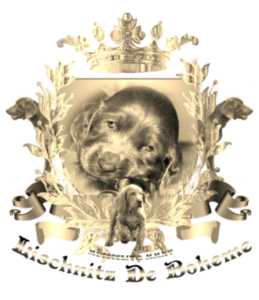
MAGYAR VIZSLA

Magyar Vizsla is a dog breed from Hungary and belongs to the FCI group 7 (Pointer group). The Hungarian or Magyar Vizsla are sporting dogs and loyal companions. The Vizsla’s medium size is one of the breed’s most appealing characteristics. As a hunter of fowl and upland game, the Vizsla has held a prominent position among sporting dogs – that of household companion and family dog.
The Vizsla is a natural hunter endowed with an excellent nose and outstanding trainability. It was bred to work in fields, forests or bodies of water. Although they are lively, gentle-mannered, demonstrably affectionate and sensitive, they are also fearless and possess a well-developed protective instinct.
The Vizsla is a short-coated hunting dog of distinguished appearance and bearing. Robust, but rather lightly built, they are lean dogs that have defined muscles.
The nose of the Vizsla will always have a reddish color that blends with the coat color. Black, brown, light pink, or another color nose is an indication of another breed. A Vizsla’s eye and nail color should also blend with the coat color.
The standard coat is a solid golden rust color in several shadings. The coat could also be described as a copper-brown color, russet gold, and dark sandy gold. Solid, dark, mahogany red and pale yellow are considered faults and a disqualification in competitions. Small areas of white on the fore-chest, neck, or tail are permissible, but not preferred. Some variations in the Vizsla coat color along their back (saddle-type marks) are typical.
The American Kennel Club (AKC) breed standards for the Vizsla states that the coat should be short, smooth, dense, and close-lying, without a woolly undercoat. The Vizsla is not suited to being kept outside since, unlike most other breeds, it does not have an undercoat. They are self-cleaning dogs and rarely need to be bathed, if ever. They have little noticeable “dog smell” detectable by humans. After several forays into lakes and streams they will develop an aroma that is a weaker version of the ‘wet dog’ smell. A quick bath and this odor will vanish.
Magyar Vizsla is a medium-sized dog, The average height and weight:
Males
Height: 23–27 in (58–69 cm)
Weight: 45–66 lb (20–30 kg)
Females
Height: 21–24 in (53–61 cm)
Weight: 40–55 lb (18–25 kg)
Vizslas are very high energy, gentle-mannered, loyal, caring, and very affectionate. They quickly form close bonds with their owners, children, and even strangers. Often, they are referred to as “velcro” dogs because of their loyalty and affection. Vizslas will cry or whine when they feel neglected or are otherwise unhappy. Some will bark at strangers if they feel that they are invading the “pack” space. They are very good guard dogs when trained to be so.
They are natural hunters with an excellent ability to take training. Not only are they great pointers, but they are excellent retrievers as well. They will retrieve on land and in the water making the most of their natural instincts. However, they must be trained gently and without harsh commands or strong physical correction, as they have sensitive temperaments and can be easily damaged if trained too harshly. However the owner must show quiet authority in training, otherwise the dog is likely to take over the training session.
Vizslas thrives on attention, exercise, and interaction. They are intelligent dogs and need a lot of mental stimulation when young. If left alone for long hours, they can be bored and become destructive. With proper socialization and training, Vizslas are very gentle dogs that can be great around children. The Vizsla wants to be close to its owner as much as possible.
Vizslas that live in cold weather climates often need protection from the harsh conditions.
Unlike many other dogs, Vizslas do not have an undercoat. Therefore, they are unsuited for living outdoors.
HISTORY
The first written reference to Magyar Vizsla dog breed has been recorded in the Illustrated Vienna Chronicle prepared on order of King Louis I of Hungary by the Carmelite Friars in 1357.
As companions of the early warlords and barons, Vizsla blood was preserved pure for centuries by the land-owning aristocracy who guarded them jealously and continued to develop the hunting ability of these “yellow-pointers”. Records of letters and writings show the high esteem in which the Vizsla was held.
The Vizsla has survived the Turkish occupation (1526–1696), the Hungarian Revolution of 1848, World War I, World War II and the Hungarian People’s Republic. However, Vizslas faced and survived several near-extinctions in their history, including being overrun by English Pointers and German Shorthaired Pointers in the 1800s (Boggs, 2000:19) and again to near-extinction after World War II. A careful search of Hungary and a poll of Hungarian sportsmen revealed only about a dozen Vizslas of the true type still alive in the country. From that minimum stock, the breed rose to prominence once again. The various “strains” of the Vizsla have become somewhat distinctive as individuals bred stock that suited their hunting style. Outside Hungary, vizslas are commonly bred in Romania, Austria, Slovakia, and Serbia.
The Vizsla started arriving in the United States at the close of World War II. As interest in and devotion to the breed began to increase, owners formed the Vizsla Club of America in order to gain AKC recognition. As a result of registering foundation stock with the AKC, Vizsla owners were able to obtain official recognition on 25 November 1960, as the Vizsla became the 115th breed recognized by the American Kennel Club.
The Vizsla was used in development of other breeds, most notably the Wirehaired Vizsla and German Shorthaired Pointer breeds. There is much conjecture about those same breeds, along with other pointer breeds, being used to reestablish the Vizsla breed at the end of the 19th century.


